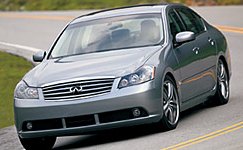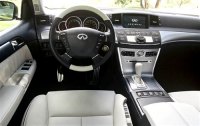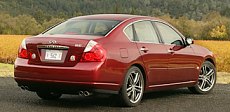|
 With
the launch of Infiniti M-series, Nissan's product lineup reform has
finally completed. In the past, Nissan did not have any strong products
to compete in the executive sedan segment, which is dominated by
Mercedes E-class and BMW 5-Series. In Japan, Nissan used to have Gloria
and Cedric to please those conservative businessmen. But they had
little chance for export, thus in the eyes of Carlos Ghosn they were
not cost effective. On the other hand, Infiniti (Nissan's overseas
premium brand) needed an executive sedan to fill the gap between G35
and Q45. That's why Ghosn decided to build a new executive car for the
global market. It will be called Infiniti M in overseas or Nissan Fuga
in Japan. The latter will replace both Gloria and Cedric. With
the launch of Infiniti M-series, Nissan's product lineup reform has
finally completed. In the past, Nissan did not have any strong products
to compete in the executive sedan segment, which is dominated by
Mercedes E-class and BMW 5-Series. In Japan, Nissan used to have Gloria
and Cedric to please those conservative businessmen. But they had
little chance for export, thus in the eyes of Carlos Ghosn they were
not cost effective. On the other hand, Infiniti (Nissan's overseas
premium brand) needed an executive sedan to fill the gap between G35
and Q45. That's why Ghosn decided to build a new executive car for the
global market. It will be called Infiniti M in overseas or Nissan Fuga
in Japan. The latter will replace both Gloria and Cedric.
The Infiniti M can be described as a grown-up version of Infiniti G35.
It shares the FM (front-midship) platform with its little brother, but
its body is enlarged in all dimensions – 16.5 cm in length, 4.5 cm in
width, 4 cm in height and 5 cm in wheelbase. This make it slightly
larger than a Mercedes E-class.
From outside, the M-series looks more modern than its predecessor
Gloria and Cedric, but that alone is nothing worth amazing. Compare
with Audi A6, BMW 5-Series, Mercedes E-class and Lexus GS, the Nissan
executive car looks relatively conservative. This is partly due to the
predictable shape, partly due to the elevated height of 1510 mm, which
delivers a slightly bulky feel.
In contrast, the cabin looks more creative. The wave-shape dashboard is
inspired by piano keyboard. (One magazine criticized it look like an
ATM machine, but as long as it looks stylish, who cares?) Its two-step
structure enhances the perception of space. Materials quality, fit and
finish of the cabin are markedly improved from G35 and other Nissan
cars, including the flagship Q45, but compare with Audi, BMW, Mercedes
and Lexus it still trails a little behind. Unfortunately, this is where
people distinguish a truly premium car from second division players.
Take note, Ghosn.
 Like
G35, the cabin is occupied by a large transmission tunnel in the same
way as some sports cars. This limit the legroom of the center rear
passenger, but the other 4 occupants enjoy abundance of head, shoulder
and leg room. Admittedly, apart from Jaguar S-Type I don't think any
main competitors are short of cabin space. Like
G35, the cabin is occupied by a large transmission tunnel in the same
way as some sports cars. This limit the legroom of the center rear
passenger, but the other 4 occupants enjoy abundance of head, shoulder
and leg room. Admittedly, apart from Jaguar S-Type I don't think any
main competitors are short of cabin space.
The M-Series shares most important mechanicals with G35. This include
the same suspensions (double-wishbones up front and multi-link at the
rear), the V6 engine, the 5-speed automatic gearbox, steering rack and
various electronics. Nevertheless, some 60% components are reported to
be new, such as the addition of active rear-wheel steering and a
4.5-litre V8 engine, though the latter comes straight from Q45.
The steel monocoque chassis is not only enlarged from G35, but also
strengthened considerably to enhance suppression to noise and
vibration. Moreover, a lot of sound deadening materials are employed to
filter road noise, engine noise and wind noise from the cabin.
Unfortunately, this is also reflected on scale - the M35 weighs a hefty
1760 kg, about 200 kg more than class average ! The M45 is also more
than 100 kg heavier than most V8 rivals. Blame to the lack of weight
saving measures.
Nevertheless, the M-series have a pair of powerful engines. M35 is
powered by a 280 horsepower version of the G35's 3.5-litre dohc V6,
while M45's 4.5-litre V8 pumps out 335 horsepower. (Note: in Japan,
Nissan Fuga only offers the 3.5 V6 and a smaller 2.5 V6). Accompany
with a responsive 5-speed automatic transmission and performance tires,
the M35 and M45 accelerate to 60 mph in only 6.3 and 5.6 seconds
respectively. Even a manual-shift BMW 530i and 545i will find it hard
to beat the Nissan.
On the down side, the Infiniti is very thirsty. According to EPA
figures, M35 returns only 18 miles per gallon in city and 25 mpg on
highway. For comparison, Mercedes E350 and Lexus GS300 return 22 / 30
mpg, while BMW 530i (6A) returns 19 / 29 mpg. This could limit its
success in Europe - if Nissan determine to export it there - where fuel
price and environmental concern are much higher than in the United
States. In fact, Nissan designed the Infiniti M-series according to
American taste. It has big engines, big power and big torque to counter
balance the big and heavyweight body. The pursuit for low price ruled
out any lightweight materials and fuel-saving engine technologies. You
can't find any aluminum bonnet or body panels, nor magnesium dashboard
mount, direct injection, 6 or 7-speed gearbox…
 On the
road, the M-series is fast and fun to drive. While both engines are not
the most refined in the class, they are strong, torquey and responsive
to throttle input. The same goes for the 5-speed automatic
transmission, which shifts smoothly and remarkably responsive in manual
mode. This allows a seamless transmission of power from the throttle
pedal to the rear tires. The unity of the powertrain is really
impressive. On the
road, the M-series is fast and fun to drive. While both engines are not
the most refined in the class, they are strong, torquey and responsive
to throttle input. The same goes for the 5-speed automatic
transmission, which shifts smoothly and remarkably responsive in manual
mode. This allows a seamless transmission of power from the throttle
pedal to the rear tires. The unity of the powertrain is really
impressive.
In contrast to Lexus GS, the Infiniti's suspension tuning biases
towards the sporty side, especially if you choose the sport package
with stiffer setup, 19-inch wheels and aggressive tires. On broken
surfaces, it rides slightly harsh and transmits more suspension noise
into the cabin. However, on fast, open road it damps beautifully and
delivers a smooth ride.
The M-series is neither the most nimble nor the best balanced car in
the class. In the twisties it could feel slightly oversized and
overweight. Give it more space and pace it starts delivering its best -
stable body control, high cornering limit (thanks to those 245 tires)
and the general free of understeer. Its Rear
Active Steer plays an important role here, helping the large M to
turn into and exit corners fluently. The communicative, naturally
weighted steering is also a delight.
All these goodies make the Infiniti M / Nissan Fuga a good driver's
car. Owners of Gloria and Cedric will not believe this is the
replacement to their cars. While it still lacks the quality and
completeness of German premium sedans, its considerably lower price
should tempt some people away from its competitors. However, the
biggest victims could be other Japanese executive cars - Lexus GS and
Honda Legend (Acura RL), especially the latter.
Rear Active
Steer: 20 years have passed since Nissan pioneered production
4-wheel-steering system in Skyline. The technology once went out of
production after Skyline GT-R died in 2002. Now Nissan resurrected this
technology to deal with the 2900mm wheelbase of Infiniiti M-series. In
order to quicken the steering response of the big M, the system uses
electric motors to move the lower links of the rear suspensions. This
varies the toe angle of the rear wheels by up to +/- 1 degree.
How
large the toe angle is controlled by electronics depending on speed and
steering angle. When the car is entering a turn, the rear wheels will
be steered in opposite direction to sharpen initial turn-in, and then
gradually shift to the same direction as the front wheels when the car
is exiting the bend to enhance stability. In short, rear active steer
is used to eliminate the undesirable understeer and oversteer that
would have occurred in conventional cars. |